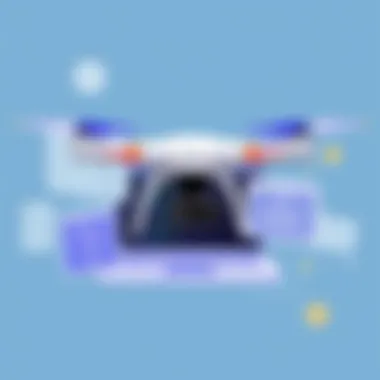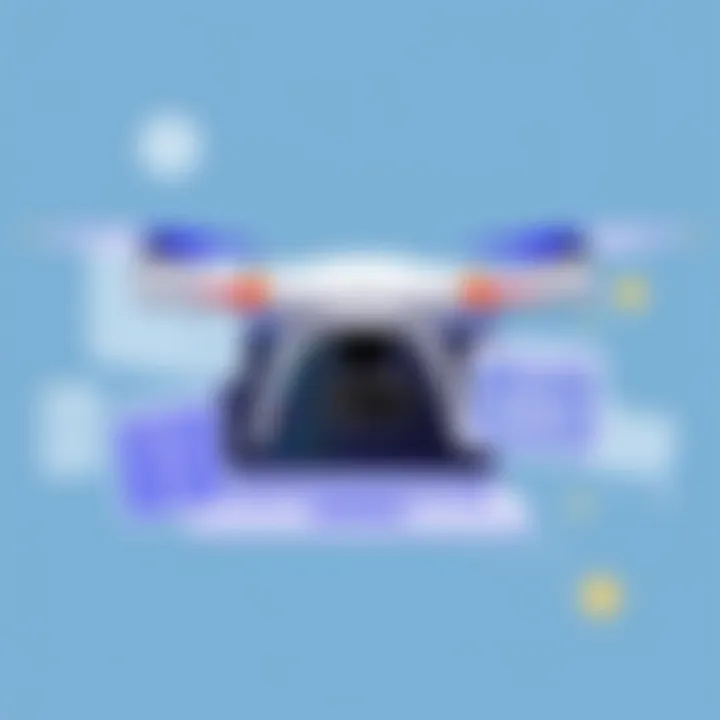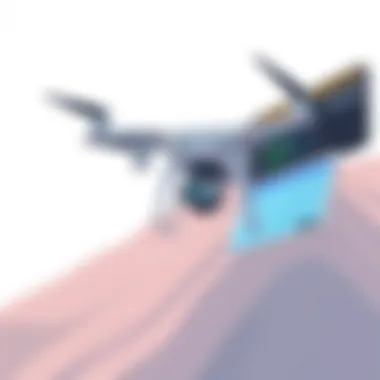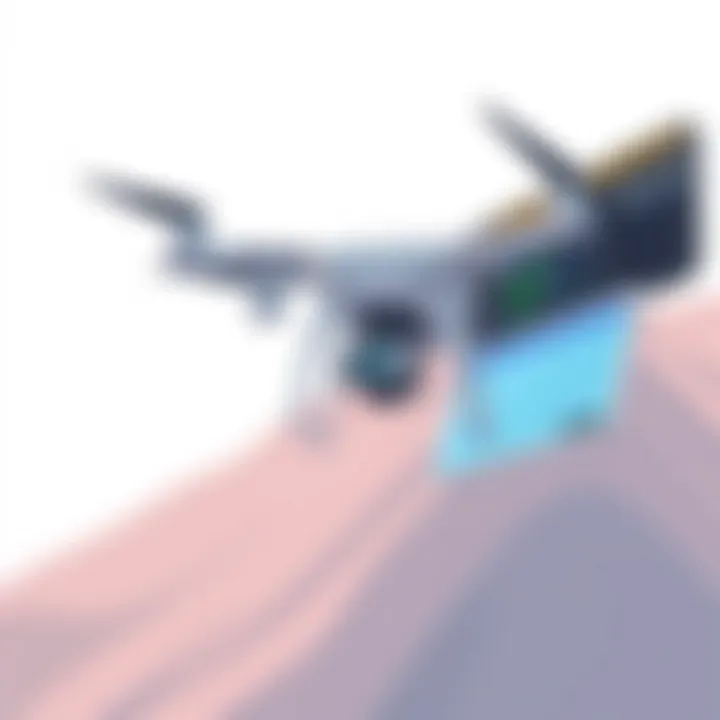Top DroneDeploy Alternatives for Aerial Mapping


Intro
The rise of drone technology has redefined how various industries approach aerial mapping and data analysis. While DroneDeploy has carved out a significant niche in this domain, its limitations often lead users to seek alternatives better suited to their specific needs. Whether you're a surveying professional, a construction manager, or simply a drone enthusiast, understanding your options is crucial for optimizing your workflows. In this guide, we will explore a selection of alternatives to DroneDeploy, breaking down their key features and benefits, conducting a direct feature comparison, and evaluating pricing structures to ensure you find the right fit for your operations.
Key Features and Benefits
Overview of Features
When it comes to aerial mapping software, having a diverse toolkit can make a world of difference. Below are some notable features typically found in alternatives to DroneDeploy:
- Real-time Data Processing: Several software platforms allow for immediate data processing while in the field, reducing downtime.
- Customizable Workflows: Users often appreciate the ability to tailor workflows based on project requirements, accommodating both simple and complex tasks.
- Integration Capabilities: Seamless integration with other software like GIS tools demonstrates a platform's flexibility in handling diverse needs.
- User-Friendly Interfaces: Many alternatives offer intuitive design, enabling even novice users to feel comfortable navigating their features.
- Advanced Analytics Tools: These tools help users derive insights from captured data, offering deeper information than basic surveying tools.
Benefits to Users
Utilizing alternatives to DroneDeploy can yield substantial benefits depending on individual or organizational requirements:
- Cost-Effectiveness: Some alternatives may present a more budget-friendly option, particularly for small to medium enterprises.
- Feature-Rich Options: In contrast to DroneDeploy, various software solutions may provide advanced features tailored to niche applications, such as agriculture or mining.
- Job-Specific Solutions: Many platforms focus on specific industry needs, enabling users to take advantage of specialized tools rather than utilizing a one-size-fits-all approach.
- Robust Customer Support: With some alternatives, users may find more approachable help desks and community support, enhancing overall user experience and satisfaction.
Comparison with Alternatives
Head-to-Head Feature Analysis
To truly appreciate the breadth of available software options, we’ll conduct a comparison of features among popular alternatives:
- Pix4D: Known for its detailed analytics capabilities, Pix4D excels in providing outputs tailored for the construction and surveying industries.
- Skyward: This platform is lauded for its project management capabilities alongside mapping, ideal for businesses needing a comprehensive solution.
- propeller: Designed specifically for the construction sector, Propeller offers features like UAV data capture and site management, setting it apart.
By analyzing features side by side, users can determine which software best aligns with their operational needs while maximizing efficiency.
Pricing Comparison
The cost of drone software can vary significantly based on the features, support, and overall value provided. Here’s a general overview of pricing structures:
- DroneDeploy: Primarily subscription-based, with costs ranging from $99 to $499 per month, depending on features.
- Pix4D: While having a free trial, it typically starts around $350 per month for comprehensive features.
- Skyward: Pricing also operates on a subscription model starting at approximately $120 per month.
- Propeller: Tends to offer project-specific pricing, ensuring that clients pay only for the services they use.
While comparing the costs, it’s prudent to consider not just the base price but also the potential ROI based on the features and benefits unique to each software platform.
"Choosing the right drone software is as important as the drone itself. The two must work in tandem to deliver accurate, actionable insights."
This guide aims to provide a clear, comprehensive understanding of alternatives available to DroneDeploy. At the end of the day, selecting a software solution that aligns both with technical requirements and budgetary constraints can significantly enhance aerial mapping and data analysis outcomes.
Understanding the Drone Deploy Ecosystem
Understanding the ecosystem surrounding DroneDeploy is pivotal for anyone contemplating its use or contemplating shifting to alternatives. The landscape of drone software technologies is ever-changing, and grasping how DroneDeploy fits into this dynamic can clarify the decision-making process. By focusing on key components and the overall impact of the software, one can better appreciate its relevance in the industry.
A central element worth noting is DroneDeploy's integration capabilities. The software connects seamlessly with hardware vendors, allowing users to harness the potential of different drone models effectively. This interoperability is crucial, as it ensures a smoother workflow from flight to data analysis. Those involved in industries such as construction, agriculture, or surveying can leverage these integrations to generate precise mapping or monitoring results with minimal friction. Moreover, users benefit from real-time insights and the ability to share data instantly with stakeholders, leading to quicker decision-making.
Another benefit lies in the user-friendly interface. DroneDeploy aims to cater to both novice drone pilots and seasoned professionals, simplifying the flight planning and data analysis process. This accessibility can be a game changer, particularly for smaller businesses or teams with limited expertise in drone technology.
Lastly, the growth of DroneDeploy’s capabilities reflects the shifting demands of users. As aerial data collection grows in popularity, understanding how DroneDeploy adapts and evolves can help potential users assess if it aligns well with future needs. Notably, being aware of the potential limitations can guide businesses in exploring other software options. This careful evaluation ensures that one is not only well-informed but also strategically positioned for optimal efficiency in their operations.
Identifying Limitations of DroneDeploy
In the realm of aerial mapping and data analysis, understanding the limitations of a tool like DroneDeploy is essential for users aiming to maximize their operational efficiency. While it offers a host of features, unearthed issues can hinder workflow and ultimately steer users towards alternatives better suited to their specific needs. Identifying these limitations provides a foundation for making informed decisions when embarking on drone projects. This section highlights crucial aspects that can impact user experience and operational effectiveness.
Cost Factor
Cost analysis is one of the first considerations when assessing DroneDeploy. While the initial investment may seem reasonable at first glance, it's the hidden costs that tend to creep up and bite users. Subscriptions can increase significantly depending on the features selected. For businesses—especially smaller ones—these price scales can become untenable.
For instance, a professional photographer might find the basic plan does not cover necessary features, steering them towards pricier options. Here are a few points worth considering:
- Monthly and Annual Payments: Depending on the chosen plan, some users may not realize that opting for annual payments can lead to hefty sunk costs if the software doesn’t meet expectations.
- Add-On Features: Certain essential functionalities, such as advanced analytics or cloud storage, may require additional fees, which can quickly add up.
- Competitor Price Comparison: Some alternatives, like Pix4D or Agisoft Metashape, offer more competitive pricing for similar capabilities, making them attractive prospects.
The long and short of it is, carefully considering ongoing costs and potential hidden fees is critical when evaluating DroneDeploy's overall affordability.
User Interface Challenges


Another salient limitation of DroneDeploy is its user interface, which some users find less intuitive than desired. The user experience can greatly affect productivity, particularly for teams that rely on rapid deployment and analysis of drone data. When navigating through complex dashboards and numerous layers of information, frustration might outweigh the benefits.
Key points regarding user interface challenges include:
- Navigation Complexity: New users often report feeling overwhelmed by the myriad options presented, which can lead to a steep learning curve.
- Visual Clutter: A cluttered interface can mask essential functions. This can cause bottlenecks, as users waste precious time figuring out where to find features.
- Mobile Experience: The mobile app interface lacks some capabilities that exist on the desktop version, which can be a disadvantage for users looking to conduct fieldwork on the go.
Proper training can mitigate some issues, but the underlying reality remains: if an application is not user-friendly, it detracts from its overall effectiveness.
In summary, acknowledging the cost implications and interface challenges of DroneDeploy enlightens users on potential friction points. By identifying these limits, organizations can better navigate their options, ensuring that their investment aligns with operational requirements and leads to successful outcomes in aerial data analysis.
Key Alternatives to Consider
In the landscape of drone software solutions, knowing the various alternatives to DroneDeploy is essential for any professional looking to harness the full potential of aerial mapping and data analysis. While DroneDeploy has carved out a significant niche, its constraints, particularly in terms of cost and functionality, can lead businesses to a diverse selection of alternatives. Each option has unique strengths and potential drawbacks, and understanding these can mean the difference between mediocre outcomes and highly efficient aerial data collection.
Exploring alternatives can offer tailored solutions that fit specific industry needs, be they in construction, agriculture, or environmental monitoring. When evaluating options, one should consider factors such as mapping capabilities, ease of use, and integration with existing tools. This can lead to a positive return on investment and improved operational efficiency in drone operations.
Pix4D: A Competitive Edge
Pix4D serves as a powerful alternative, blending sophisticated technology with user-friendly interfaces. Founded in 2011, its dedication to photogrammetry offers robust capabilities that meet several sectors' requirements.
- Key Features: Pix4D’s platform allows for real-time processing, which is particularly beneficial when insights are needed quickly. This can be a game-changer in project timelines, especially in industries like construction and land surveying.
- Use Cases: For agricultural professionals, using Pix4D can facilitate crop monitoring and yield prediction through its accurate mapping tools and analyses. Construction companies benefit from accurate site assessments and progress tracking.
Unlike DroneDeploy, Pix4D provides detailed customization options, allowing users to tweak models according to specific needs, enhancing its applicability across varying sectors.
Agisoft Metashape: A Detailed Look
Agisoft Metashape is another contender that is highly regarded for its depth in photogrammetric processing. It’s often praised for its mapping precision, making it a preferred choice for professionals who demand accuracy.
- Technical Prowess: Metashape supports various input formats and excels in high-resolution mapping tasks. It is suitable for creating topographic maps, 3D models, and even complex data sets for archaeological purposes.
- Learning Curve: While its capabilities are vast, it does require a bit of a learning curve. Users should be prepared to invest time in understanding its features to maximize the software's potential.
Propeller: Tailored Solutions for Construction
Propeller stands out as a drone software specifically tailored for the construction industry. Its design philosophy revolves around simplicity and efficiency, aimed directly at construction professionals.
- User-Focused Solutions: With Propeller, users can conduct site surveys and manage project development more effectively. Its dashboards present key metrics at a glance, making it easy for stakeholders to keep up with project status without diving deep into data analytics.
- Integration: One of the significant appeals of Propeller lies in its ability to integrate seamlessly with existing construction project management tools, thereby fitting well into established workflows.
DroneLink: Focus on Automation
DroneLink differentiates itself by placing a strong emphasis on automation in drone operations. This is particularly useful for industries that require frequent aerial data collection.
- Automation Features: When using DroneLink, professionals can set up automated flight missions, which saves time and minimizes the potential for human error. This automation can greatly enhance productivity in settings like mining and land mapping.
- Flexibility: Additionally, DroneLink provides flexibility in flight planning and data management, catering to users who need to adjust rapidly to changing project requirements.
Skycatch: Emphasis on Mapping Accuracy
Skycatch offers specialized tools for companies that place a premium on mapping accuracy, particularly in construction and engineering.
- Precision Mapping: The software’s high-definition mapping capabilities mean that engineers can generate exceptionally detailed models, critical for infrastructure and environmental projects.
- Collaboration Tools: Furthermore, Skycatch facilitates team collaboration by providing tools designed to share insights and data effectively among project teams, increasing the overall project efficiency.
In sum, exploring these alternatives to DroneDeploy presents a wide range of functionalities tailored for different needs and sectors. Selecting the right tool often hinges on understanding specific project requirements and aligning them with the unique features offered by these competitors. The key to success lies in careful evaluation and consideration of long-term implications for operational workflows.
Comparing Key Features of Alternatives
When delving into alternatives to DroneDeploy, understanding the key features of various software solutions is paramount. This section highlights the essential aspects of mapping capabilities, data processing speed, and integration with other tools—all critical components affecting how effectively businesses can utilize drone technology for their specific needs. Without a clear comparison, users may find themselves investing in solutions that don’t align perfectly with their operational objectives. Therefore, a structured approach to evaluating these features not only improves decision-making but also ensures that investments yield beneficial outcomes.
Mapping Capabilities
Mapping capabilities serve as the backbone of any aerial data application. At a glance, this feature refers to how effectively a software platform can capture and produce maps from drone imagery. Various alternatives to DroneDeploy—like Pix4D and Skycatch—boast distinct methodologies of interpreting aerial data, resulting in varying quality and detail levels.
For instance, Pix4D specializes in creating highly detailed 3D models and maps. This platform employs advanced photogrammetry techniques that bring out intricate features in terrain, which is beneficial for industries relying on precision, such as agriculture and construction.
On the flip side, Agisoft Metashape also offers high-resolution maps but focuses on user-friendly processes, allowing beginners to produce satisfactory outputs without requiring deep technical knowledge. Users must consider factors such as terrain complexity, desired output quality, and the versatility of the software when evaluating mapping capabilities.
In the context of practicality, consider the question: "Will the generated maps serve my project's specific requirements?"
Data Processing Speed


In a world where time often equals money, data processing speed cannot be overlooked. It measures how swiftly a software solution can transform raw data into usable information. Users often find themselves frustrated by long processing times, which can delay critical decision-making processes. Here, alternatives like DroneLink and Propeller shine for their efficiency.
DroneLink achieves rapid data processing by utilizing cloud computing, which allows users to manage tasks seamlessly from remote locations. It’s particularly advantageous for real-time data analysis, which is crucial for industries such as environmental monitoring or emergency response.
Contrastingly, Propeller emphasizes how quickly it can process aerial data, streamlining reporting workflows on construction sites. A business needing results fast may prioritize software that offers quicker turnaround times, while one focused on detail could opt for software that takes longer if the outputs prove significantly better.
Integration with Other Tools
Another pivotal aspect to assess is how well these alternatives integrate with existing tools and systems. A software that doesn’t communicate well with other platforms can lead to data silos, fragmentation, and operational inefficiencies. In the current tech landscape, interoperability is key.
Integrating well with tools like GIS software or project management platforms enhances effectiveness. For example, Skycatch provides seamless integration with various GIS platforms, allowing businesses to overlay drone data directly onto their existing maps. This capability can save time and reduce errors, essential for industries that rely on up-to-date geographic information.
Agisoft Metashape allows for flexible export options to other software, ensuring that users can tailor workflows according to their preferences, while also benefiting from configurations that enhance project management.
To wrap this section up, evaluating these three distinct features—mapping capabilities, data processing speed, and integration—is vital for anyone looking to make an informed choice about drone software alternatives. Taking into account these elements not only assists in aligning technology with operational goals but also enables a strategic approach to adopting new tools that can drive efficiency and success.
"Choosing the right software can be the difference between data that informs and data that overwhelms."
Feel free to check additional resources for insights on selecting the right tools:
User Experiences and Testimonials
Understanding user experiences and testimonials is pivotal in evaluating alternatives to DroneDeploy. These insights offer a glimpse into how other professionals in the field are navigating their aerial mapping and data analysis operations. They provide context not just about product capability but also about ease of use and real-life benefits and pitfalls. Gathering feedback from industry peers can be a game changer—especially for IT and software professionals—when deciding which software to use. This section is intended to highlight individual user journeys with different tools while identifying key elements that shape their overall satisfaction and workflow improvement.
Case Studies: Successful Implementations
The effectiveness of aerial mapping software can often be illuminated through concrete case studies. Take, for instance, John Blaze, a construction manager at a mid-sized firm. He shared his transformation story with Propeller. Before making that switch, his team relied upon traditional surveying methods, which often resulted in delays. After implementing Propeller, he noted that their project timelines reduced by 30%. This, he claims, was mainly due to the ability to access real-time data right from the job site, thus enhancing operational efficiency.
"Switching to software that integrates seamlessly with our project management tools felt like unlocking a new door to productivity," John explained.
Another case involves a large agricultural company that moved from DroneDeploy to Agisoft Metashape. They were able to experience a remarkable upgrade in crop health analysis and yield prediction accuracy. Sarah, their data analyst, emphasized that *"the detailed orthomosaic maps and the ability to customize processing parameters made a world of difference for us. We could run several scenarios and make informed decisions based on that data."
These testimonials highlight not just satisfaction but very real shifts in operational capability, reflecting how effective software choice can lead to successful project execution. Customers seeking software tailor-made for their unique requirements can leverage such insights to make informed choices.
Challenges Faced by Users
While the positive experiences are valuable, it is equally crucial to shed light on the hurdles that users encounter a well. Many individuals have reported facing integration challenges when adopting new software. For example, Liam, a small business owner in logistics, discovered that DroneLink’s automation features did not align well with the other warehouse management systems in use. "It took longer than I anticipated to customize the software to fit our existing tools. I was ready to throw in the towel," he lamented.
Several users across forums like Reddit and Facebook have echoed Liam's sentiments, frequently mentioning how the learning curve of new software can be taxing on staff that are already stretched thin.
Additionally, users from various sectors have voiced concerns about the support and documentation provided by these alternative platforms. Many indicate that the lack of prompt assistance or comprehensive guides has hindered their ability to find solutions quickly. This is a critical consideration as businesses have to balance productivity with the time spent troubleshooting issues.
Cost-Benefit Analysis of Alternatives
When evaluating software choices, especially in industries revolving around aerial mapping and data analysis, a cost-benefit analysis acts as a compass guiding users through a landscape peppered with options. This analysis looks beyond the superficial appeal of software solutions and dissects the nuances behind their pricing and functionalities. Understanding the delicate balance between cost and value is crucial for IT professionals, software developers, and businesses alike as they aim to derive optimal returns from their investments.
To put it simply, making a choice without doing a proper cost-benefit analysis can be like putting a cart before a horse. Beyond the dollar figures, it also encompasses considerations such as efficiency, ease of use, compatibility with existing systems, and support services. This section reveals the intricacies of the cost-benefit analysis, shedding light on pricing structures and value for money to help users make educated decisions.
Pricing Structures Compared
One of the first factors that crops up in a cost-benefit discussion is the pricing structure of alternatives to DroneDeploy. Different software solutions offer varied pricing models that cater to a broad spectrum of users. Let's explore how these structures differ:
- Subscription Model: This is a popular choice, often billed monthly or annually, which spreads costs over time. Tools like Pix4D use this model, making it easier for businesses to plan expenses without a hefty upfront payment.
- Pay-per-Use: Some software solutions, like Agisoft Metashape, may charge based on the number of images processed or the extent of features utilized. This model can be advantageous for companies that don't need consistent usage but still require high-quality output on demand.
- One-Time Purchase: Options like DroneLink emphasize a one-time payment without recurring fees. While the initial outlay might be larger, long-term users may find this method to be more cost-efficient in the long run.
- Tiered Pricing: Certain platforms, such as Propeller, provide tiered plans, offering different levels of service to accommodate both small teams and large enterprises. This flexibility can entice users to upgrade as needs evolve.
Understanding these varied pricing structures is key because it enhances the ability to align software choices with operational budgets and frequency of use. Each model comes with its own set of pros and cons. Thus, dissecting these nuances leads to a narrowing down of viable options that align with both operational needs and financial capabilities.
Value for Money Assessment
Once pricing structures have been sketched out, the next step is a value for money assessment. This measures not just the price tag attached to a software solution, but also seeks to determine its effectiveness, usability, and support features. Remember, a lower price doesn’t always equate to a sharper deal.
- Feature Availability: Does the software provide the essential features that meet the users’ requirements? For instance, if users value mapping precision, are they getting advanced functionalities or merely basic offerings?
- Operational Efficiency: How quickly does the software process data? If a tool is slow or complicated, it might waste hours that could otherwise be better spent. In a fast-paced environment, time is money, and inefficiencies can cut deep into profits.
- Customer Support: Excellent documentation and responsive support teams can be worth cutting costs elsewhere. If a software program runs into issues, having a reliable help desk can forestall chaos during critical operations.
- User Community: A robust user community can provide additional resources, tips, and peer support that enhances user experience, directly affecting overall satisfaction. A larger community around platforms like Skycatch can mean more shared knowledge and troubleshooting help.
Ultimately, the assessment of value for money requires a holistic approach, taking into consideration both tangible and intangible factors. Each potential alternative should be measured against its pricing, but also against how well it fits into the user’s workflow and goals. This overall evaluation is necessary for making a sound decision on what fits best in the long haul, serving as substantive information for those navigating their options in aerial mapping software.


Assessing Long-Term Viability
When evaluating the efficacy of drone software, the importance of its long-term viability cannot be overstated. The rapidly evolving landscape of drone technology means that businesses must consider not just the initial appeal of a software solution, but also its sustainability and adaptability over time. This section will explore key factors that constitute long-term viability, offering insights into how these elements play a critical role in ensuring that the chosen tool continues to deliver value in the years ahead.
Specific Elements to Consider:
- Adaptability to Technological Changes:
The drone industry is anything but static. With advancements sprouting from every corner—from improved battery technologies to enhanced data processing capabilities—software must not only keep pace but also adapt swiftly. A viable solution should include mechanisms for continuous updates and modular expansions to accommodate emerging technologies. - User Support and Documentation:
The effectiveness of support provided can dictate how well users can utilize the platform long-term. A robust support structure, complete with comprehensive documentation and straightforward troubleshooting resources, helps users feel confident and makes the software easier to navigate over time. - Community and Ecosystem Development:
Thriving user communities often enhance the value of software through shared insights and updates. A platform that fosters engagement among its users can lead to rich repositories of knowledge and solutions that improve the user experience and facilitate innovation. - Pricing and Cost Stability:
As software progresses, so might its costs. A clear understanding of the pricing structure and potential for adjustments is necessary to assess whether it's a sound investment. Evaluate the potential for 'feature creep' in pricing as new capabilities are added, influencing the long-term budget. - Regulatory Compliance:
With drones frequently under scrutiny from regulatory bodies, ensuring that a software solution adheres to compliance requirements is essential. Staying ahead of regulatory changes prevents costly disruptions and ensures future readiness.
Assessing long-term viability isn’t a one-time task, but an ongoing process driven by user experiences and market shifts. When choosing software for drone operations, it is crucial to weigh these fundamental aspects to make an informed decision that supports future growth.
Software Updates and Support
In the context of drone software, timely updates and effective support are essential for maintaining operational efficacy. They represent much more than just technical enhancements; they are the lifeblood that keeps a platform running smoothly as new features are rolled out and issues are addressed.
Why Software Updates Matter:
When updates are infrequent or poorly executed, users may find themselves grappling with outdated functionality or, worse yet, security vulnerabilities. **Consistent updates can:
- Introduce new features that leverage emerging technologies, strengthening competitive positioning.
- Fix bugs swiftly, ensuring users can utilize the software without interruptions.
- Improve user interface based on feedback, making it easier to navigate through tasks.**
For instance, software like Agisoft Metashape often rolls out updates that dramatically improve processing speed and accuracy. This responsiveness not only enhances the usability experience but also reassures users that the developers are attentive to their needs.
Community and Developer Engagement
The strength of a software platform’s community can offer a wealth of resources and collaborative problem-solving opportunities. Engaged users bring diverse perspectives and can often pinpoint issues or suggest enhancements that developers may not have considered.
Benefits of Community Engagement:
- Resource Sharing: Users often create tutorials, blogs, and forums that illuminate lesser-known features or tricks.
- Feedback Loops: Engaged communities foster direct channels for user feedback, which can guide developers in honing their software products effectively.
- Collaborative Innovation: When users suggest features, or submit code, developers can accelerate innovation beyond their internal capabilities.
Platforms like Pix4D exhibit strong community engagement, creating forums where users exchange ideas and solutions, ultimately elevating the software functionality.
Engaging with both the developer team and fellow users can enhance one's experience significantly. Such platforms invite users not only to participate but also to actively influence the trajectory of the software's evolution, keeping it relevant in the competitive drone sphere.
By focusing on software updates and community engagement, users can secure a robust platform capable of evolving alongside their operational needs. Keeping these aspects in mind during the selection process will lead to a more sustainable investment and a positive long-term relationship with the software.
Ending: Making the Right Choice
Making the right choice in software solutions for drone operations cannot be overstated. As we’ve explored throughout this guide, understanding the limitations and functionalities of tools like DroneDeploy is critical. However, this inquiry extends beyond simply identifying what one product can or cannot do. It involves a deeper dive into assessing needs, cost constraints, and desired features.
For many businesses, the stakes are high. Effective aerial mapping and data analysis can enhance operational efficiency, improve decision-making, and ultimately lead to a significant competitive edge. Each alternative discussed offers unique strengths tailored for various industries—whether it's construction, agriculture, or environmental monitoring. Therefore, comprehending what each tool excels at is paramount.
Moreover, the rapidly evolving technology landscape means that the best choice today might not hold the same value tomorrow. Organizations must adopt a mindset of continuous learning and adaptability. Decisions should be informed not only by current capabilities but also by future roadmaps of the tools in question.
In short, making the right choice involves:
- Assessing individual and organizational needs.
- Comparing features and capabilities against those needs.
- Evaluating cost versus potential return on investment.
- Considering the long-term viability of the solution, including support and updates.
"The best software solution is one that evolves with your needs while delivering results at every stage of your operations."
Summary of Findings
As we conclude this extensive exploration, several key findings emerge:
- Diverse Alternatives: The market is rich with alternatives to DroneDeploy. Each tool — such as Pix4D, Agisoft Metashape, and Propeller — brings distinct advantages that cater to specific user demands and industry requirements.
- Customizable Solutions: Many alternatives offer flexibility, integrating with existing workflows. Users can find solutions that not only fulfill their current requirements but also adapt to future challenges.
- Cost Considerations: Price varies widely across platforms, but it is essential to align expenses with the value delivered. A higher price tag does not always guarantee superior performance.
- User Engagement: The feedback from real users sheds light on practical applications and challenges faced during implementation. This firsthand information is often invaluable in making decisions that won't lead to regret.
Recommendations for Different User Types
Tailoring recommendations based on user types can enhance the decision-making process. Here are suggestions for distinct user categories:
- Small Businesses:
- Large Enterprises:
- Agricultural Professionals:
- Construction Industry:
- Solution: Consider options with lower entry costs and user-friendly interfaces like DroneLink.
- Reason: These tools are economical and suitable for straightforward operations, minimizing training time.
- Solution: Evaluate comprehensive platforms such as Agisoft Metashape and Pix4D that support complex operations and integrations.
- Reason: Their capabilities align with larger projects, providing scalability and more robust data handling.
- Solution: Explore Skycatch, which emphasizes mapping accuracy and data analysis specific to agricultural practices.
- Reason: The precision is critical for crop management and resource allocation.
- Solution: Propeller offers tailored solutions ideal for monitoring construction sites and streamlining processes.
- Reason: It ensures collaboration among teams while tracking project progress efficiently.
By consistently matching needs with the most appropriate tools, users can maximize the benefits gained from their drone technology investments.
For further reading, users might explore resources such as Wikipedia, Reddit, and Britannica to gather insights and community experiences as they embark on their decision-making journey.



